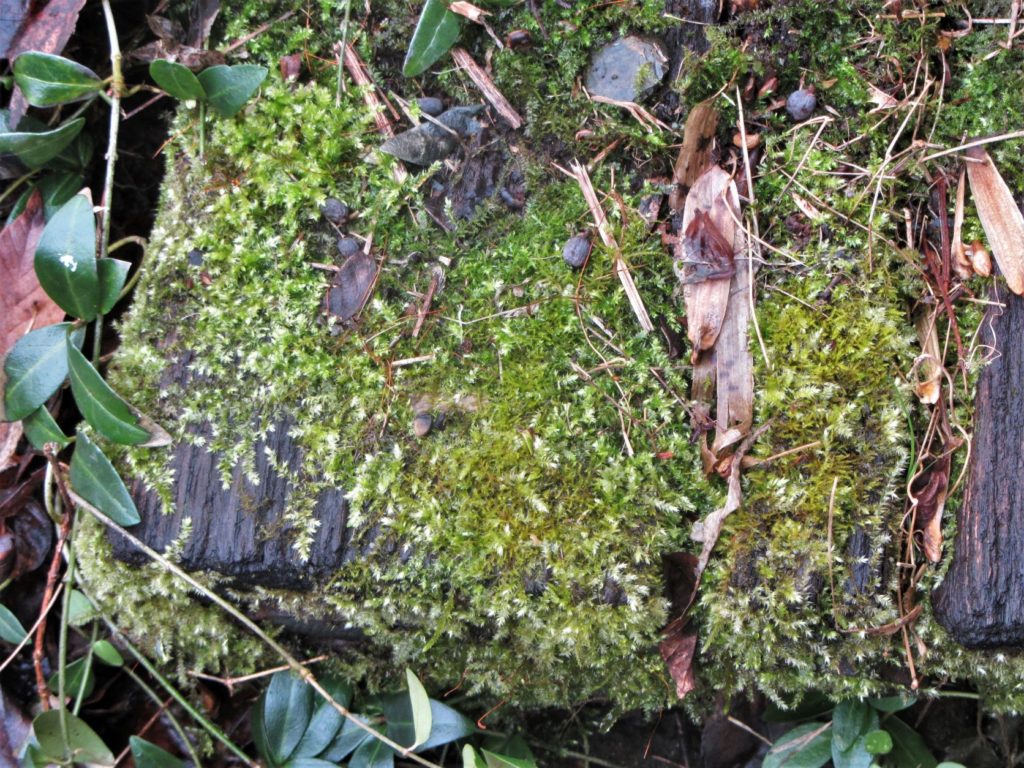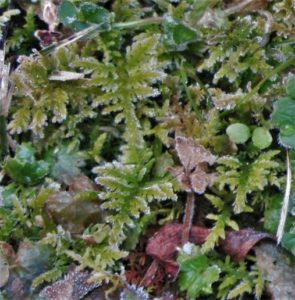Cultivating Moss Part 1: Native Mosses in the Garden
How much do you know already about mosses? They are so common; you will find them growing most anywhere. Take the Moss Quiz, and you’ll find the answers at the end of Part 2 of this post.
The Moss Quiz
1. Which will kill moss the fastest? A. Letting it dry out B. Watering it
2. Will moss make new roots if you transplant it? A. Yes B. No
3. Can I share my beer with my moss? A. Yes B. No
4. What is the fastest way to establish a new moss planting?
A. Sprinkle moss spores B. Transplant a fist sized clump of moss
C. Shred and spread my moss D. Mix powdered moss with diluted yogurt
5. Where is moss least likely to grow well?
A. In a pond B. In a terrarium C. In a lawn D. Under snow
6. Can I order hardy hybrid moss seeds from a supplier? A. Yes B. No
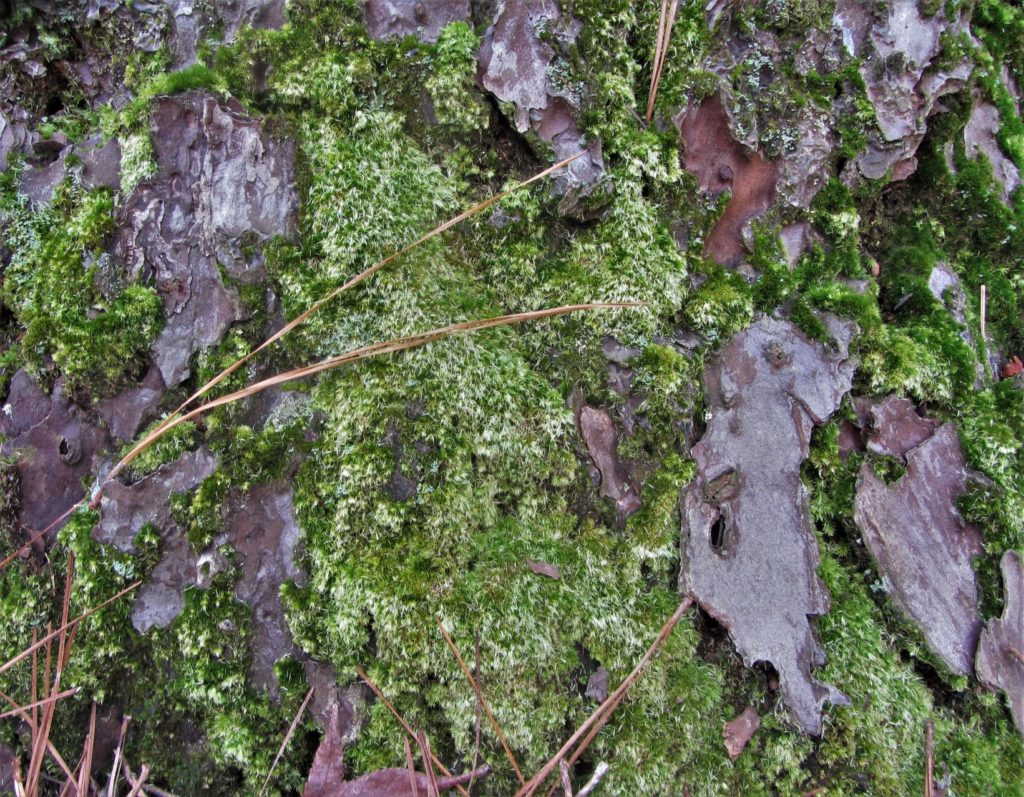
Leucobryum glaucum, pincushion moss, grows on the bark of a loblolly pine tree at the Williamsburg Botanical Garden.
Moss is an indigenous native plant. Mosses thrived in primeval landscapes eons before the first ferns and other vascular plants appeared. Moss continues to thrive in spaces both humble and grand, in the harshest conditions, on every continent and island on Earth.
Mosses glow green in the winter landscape when most other plants rest. Winter and early spring are some of the best times of year for gardeners to cultivate and propagate mosses. They enjoy the cool, damp weather that allows them to reproduce and expand. Mosses continue to sequester carbon dioxide and filter the air throughout the year, as they photosynthesize sugars to fuel their growth.
Mosses are one of the few truly ‘wild’ types of plants. Their spores travel, unseen on the wind, and colonize when they land in a hospitable place with favorable growing conditions. They magically appear in odd spots like the cracks in a sidewalk, on moist bricks, on tree bark, and in the edges of woods. Although mosses may appear and grow without a gardener’s hand, moss gardening is one of the easiest types of gardening to practice.
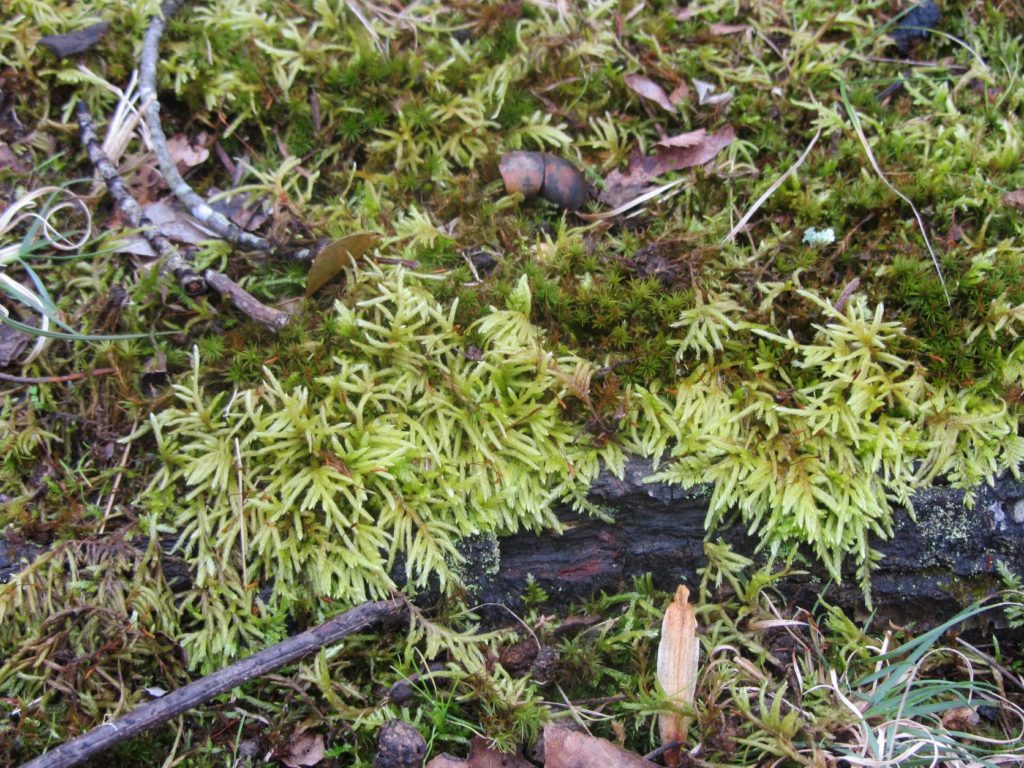
Hypnum imponens, fern moss or log moss, blends with other moss species around the roots of an old oak tree. Mosses like this have a simple vascular system connecting the leaves and stems to the plants’ rhizoids.
Most mosses are non-vascular plants, which means that they don’t have roots or a system of xylem and phloem tubes carrying water and nutrients throughout the plant. Moisture must pass directly from cell to cell in many moss genera, which is one reason that most mosses remain very small. A few types of moss have a very simple vascular system, but without lignin to strengthen it. Many mosses have very fine rhizoids to anchor them in place, and to also absorb some water and nutrients.
Although mosses can reproduce by producing spores, it is easiest to increase them through vegetative propagation. Every part of a moss plant can grow and replicate the entire plant. A bit of moss can dry out completely and then begin to grow again once it is re-hydrated. While drying, the individual cells prepare themselves to grow again once re-hydrated. Moss can grow again after years of dry storage. This allows for some interesting ways of turning a small bit of moss into a luxurious planting.
There are over 1400 species of moss in North America. You may need a hand lens to confidently identify the species of a moss you find. Few varieties have common names, and many look different depending on the season and whether they are moist or dry. Spritz water on a moss before looking for the characteristic that will help you identify it.
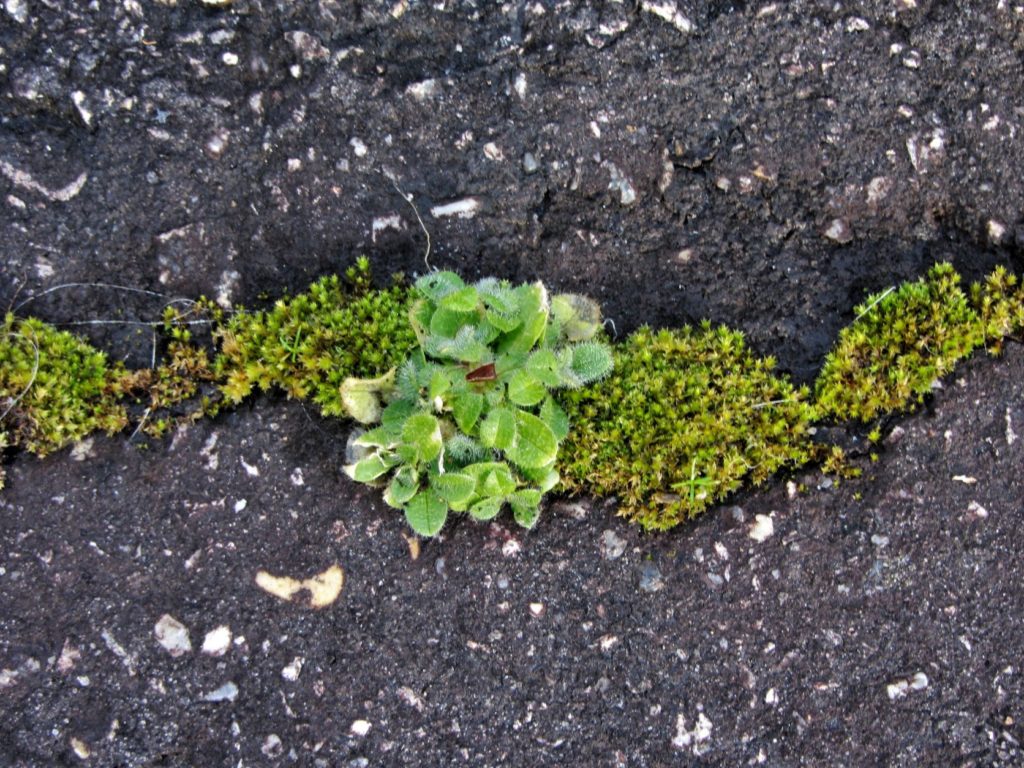
Moss growing in a crack in the driveway may be an Atrichum species. Known as star moss or starburst moss, this genus prefers acidic soil and tolerates partial sun. It will grow in cracks between pavers and along roadsides.
Many of us don’t cultivate and enjoy moss as much as we tolerate moss. A friend was troubled by so much moss growing in his shady front yard. Eventually, he realized that he liked the moss better than the grass, and so killed off his grass and encouraged the moss. Moss makes a beautiful ground cover, holds soil against erosion, and looks great growing under trees, ferns, and flowering plants. A variety of different mosses may weave themselves together in a single planting, providing interesting variations of texture and color.
Mosses may also be used as a living ‘mulch’ in containers in combination with shade loving plants, or alone. Mosses may be grown on roofs, fences, between stepping stones, and around water features. Because there is such a wide variety of different types of mosses available in most areas, it is possible to select one to match most growing conditions.
There are a few mail order nurseries that sell living moss. But most of us can easily collect moss close to home and propagate those bits into enough to accomplish our vision for our own moss gardens. I began encouraging moss as a ground cover in shady parts of my garden several years ago. I picked up small bits of moss and transplanted them to where I wanted more mosses to grow.
Since moss has no roots, ‘transplanting’ means moving a bit of moss to where you want it and securing it in place with a small stick or with floral pins. Then you press or step on it firmly to insure there is good adhesion between the bottom of the moss and the surface where you want it to grow. Some moss gardeners even suggest gluing moss in place on rocks or walls, while you wait for it to colonize.
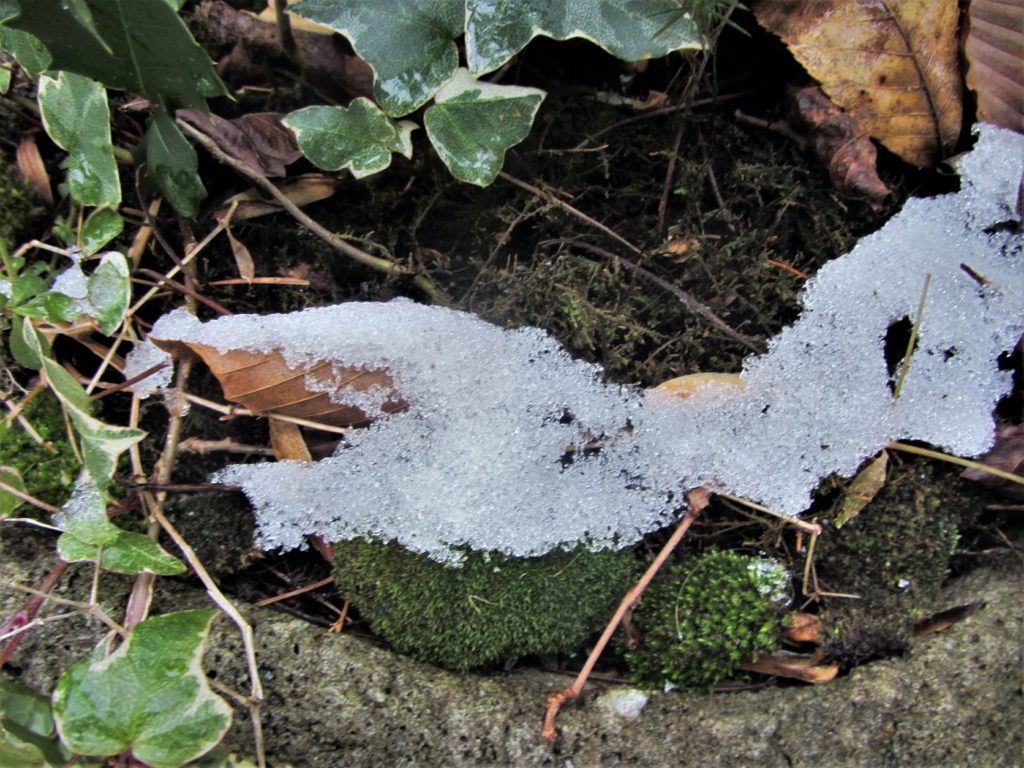
Bryum argenteum, silver moss or sidewalk moss, will grow in many different environments. It is sun tolerant and will grow between bricks in patios or in cracks in concrete. I transplanted this clump to a pot where other mosses are growing..
Sometimes it is this simple. Other times, it is a bit more complicated. Mosses have very particular needs for light, moisture, and the pH of their substrate. Mosses need consistent moisture to produce food and to grow. They can absorb humidity in the air, benefit from dew, love rain or snow, and thrive in wet spots in the yard. Mosses even live in shallow water in ponds and creeks. When hot, dry weather comes they will change color and dry out without supplemental watering. Once they re-hydrate, growth can resume.
For years I wondered why mosses I transplanted into pots and terrariums rarely thrived (and mostly died). Most mosses need an acidic to neutral environment, and most tap water is alkaline, or sweet. I recently tested my own tap water with a pH test strip, and determined that it has a pH of nearly 9, which is quite alkaline. Using tap water to water my containers with mosses raised the pH too much and eventually killed them. Tap water also contains chemicals to purify it, which may be lethal to mosses when their levels build up, as they will in a container.
Sometimes mosses have trouble colonizing potting soil, because the potting mix may have a high pH or have chemical fertilizers mixed in. Potting soil has a loose, open structure rather than the firm, compacted surface mosses prefer. Mix very finely shredded wood mulch into potting soil intended to support moss. You can even lay a thin layer of fine mulch on the soil, and press to compact it firmly, before sowing moss.
Mosses should be watered with rainwater or distilled water. When cultivated directly on the ground, the soil should be acidic, unless the moss is one of the few that prefers a more alkaline, lime-based environment. As with any plant, learn about the needs of the mosses you want to cultivate.
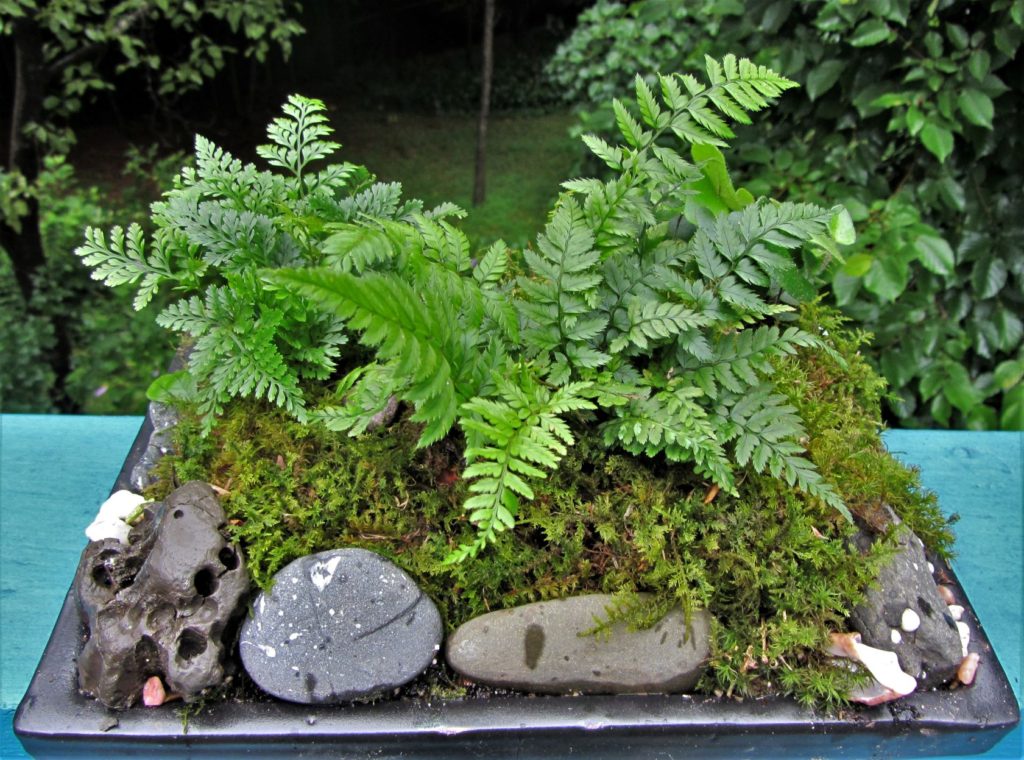
Mosses used to mulch a fern table arrangement may struggle on commercial potting soil. Water only with rain water or distilled water, as tap water will eventually kill the mosses. Learn how to lower the pH of potting soil in Part 2 of this post.
Soil in our neighborhood tends to be more acid, and mosses are colonizing more and more of my yard with each passing year. I’m pleased to see them covering areas that are challenging to mow and where I want the luster and texture of beautiful moss. While most mosses prefer full to partial shade, some varieties will tolerate a sunnier spot. You may notice moss growing between the bricks of a patio, in a crack in your driveway, or even around a sidewalk in full sun.
A few simple efforts will encourage mosses to fill in and spread. First, remove unwanted vascular plants as they appear. These may be bits of grass, wild strawberries, or other ‘volunteer’ plants otherwise known as weeds. A string trimmer used a few times a year can make quick work of this. Careful removal of individual plants out of the moss beds takes longer but gives a better result. This is most important while the mosses establish.
When leaves fall in autumn, regularly blow them away from mossy areas. If bits of moss blow up during this effort, place them in a bare spot and push and pin them into place. Keep mosses clean and uncovered so that light and moisture can reach them, and fungal disease doesn’t develop. Monitor mosses regularly so that areas that get pulled up by animals or birds can be pushed back into contact with the soil.
Once you begin to notice mosses, you’ll see them in the most unexpected places. They are a gift of nature, a useful resource, and a willing participant in the life of the garden.

This Polytrichum, or haircap moss, has long, strong rhizoids which hold the soil to prevent erosion. It will grow in sun or shade, and is resistant to pollution and toxins. There are 70 species in the genus, with worldwide distribution.
All Photos by E. L. McCoy
Continue to Cultivating Mosses Part 2: Propagation Methods
See Cultivating Moss Part 3 for more photos and further resources

